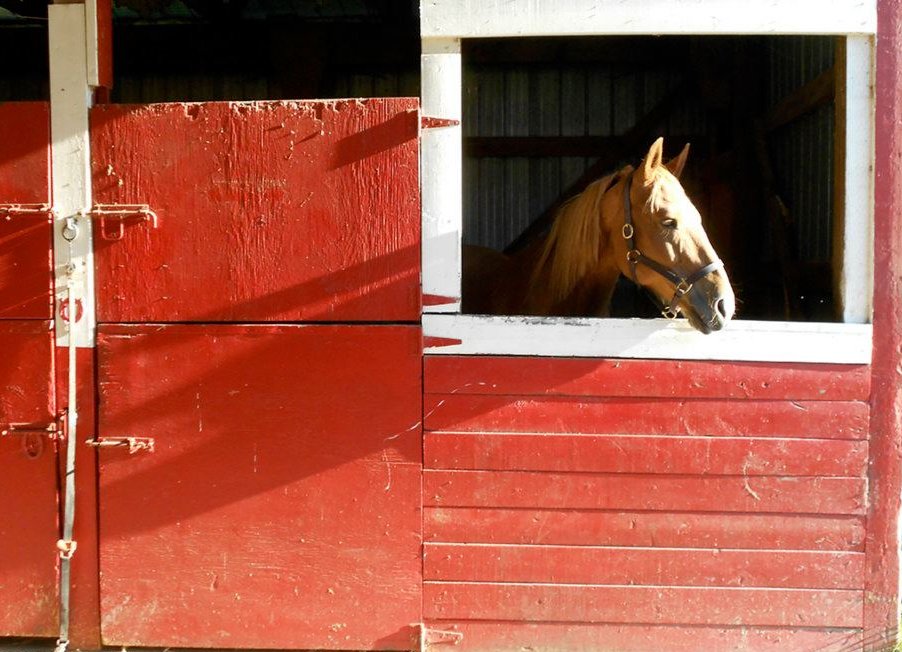Horsemanship 3 - Stall & Pasture
The first thing you will be asked on the Level 3 practical test is to
Describe good and bad features of a horse’s pasture & stall.
You can read chapters 14 and 15 of the Manual of Horsemanship for an in depth look at desirable aspects of stables and pastures. Here are a few of the key features.
Stalls (Looseboxes)
- Minimum 3.6 m2 (12 square feet) for a horse or 3.6 x 3 metres (10’x12’) for a pony
- Doors should be at least 1.1 m (approximate 3’6”) wide, and 2.1m (7’) tall
- Doors should open outward or slide
- Stall should have a window or dutch door for the horse to look out (fitted with a grill if the horse bites or weaves)
- Latches out of reach of horses (or a bottom latch added in case the top one fails)
- Flooring should be impervious to moisture and sloped for drainage. Rubber mats under the bedding help horses’ legs. Natural (dirt) flooring is easier on legs but harder to keep clean.
- Good air circulation
- Lights should be high up and covered in metal cages
- Electrical wiring should be out of reach of horses
- Waterers and mangers (if present) fixed at chest height
- Stall should be in good repair, with no loose or broken boards, protruding nails, or anything else a horse may get hung up on.
Pasture & Paddock
- Safe fencing in good repair. The best type of fencing is post and rail backed by a non-poisonous hedge. Post and rail with an electric wire is the next best, followed by electric only or electric with nylon wire. Wire mesh if used must be small enough that a horse cannot get a foot through. Page wire and barbed wire are inappropriate fencing for horses.
- Gates at least 1.5 m wide that can be operated with one hand.
- Some sort of shelter or windbreak should be available. Trees work in larger pastures; paddocks should have a shed where the horse can come and go at will.
- Fresh water supply. If this is a stream the creek bed should be gravel (sand can cause colic) and should have firm banks. Troughs and buckets can have automatic or manual refill but should be solidly placed free of sharp edges.
- Ground should be firm, not muddy, without holes, deadfalls, tangled brush, or places horses might become trapped.
- Lack of poisonous plants. These include, but are not limited to, foxglove, yew, black walnut, nightshade and laburnum. Most horses will ignore poisonous plants but if forage is lacking may start to eat them.
- If the pasture is shared with other horses there should be at least 20m square per horse to allow room for movement and to avoid conflict
This is not a comprehensive list, but if you are able to note three or four of these features to your examiner you will do fine on this portion of the test. At this level we don’t ask you about safety features for the barn and grounds in general, but there’s no harm looking those up in the manual and staying alert to potential safety hazards in any stable you frequent.
Common sense and a good eye for detail are the keys to keeping horses safe and happy. Horses are extremely curious and easily bored. As a rule of thumb if a horse can get into trouble, it will!
Upcoming Workshops & Events
Cavaliere Classes
Saturdays 16, 23 & 30 August, 6 Sept
time: 4:00 – 7:30pm
cost: $60 or 1 flex-pack credit per class
Here is an unusual chance to take weekly Cavaliere Classes. Because we didn’t run them in July, we’ll be running the classes every Saturday afternoon from August 16th through September 6th. What could be better than Horsemanship, Riding and Swordplay in the balmy August evenings at Red Colt? This is the perfect time to brush up on your skills before Carosella which is coming up September 12-14th!
Mounted Combat Workshop
Sunday 7 September
time: 1- 4pm
location: Red Colt Equestrian Farm Co-op, 12320 No 2 Road, Richmond
cost: $60
Swordplay from the ground, the falsemount, and from horseback.
prerequisites: Intro to Mounted Combat or permission from the instructor
Carosella 2014
Friday – Sunday, 12-14 September
Three full days of Mounted Combat, Archery and Skill at Arms. There will be workshops on foot and on horseback for all levels of riders. Set the days aside, and watch this space for details!
Horseback Archery
We had fabulous day of Horseback Archery on Sunday. More photos will be up on the Duello Facebook page soon, but in the meantime here are a couple. The next horseback archery workshop will happen on Friday September 12th as part of Carosella 2014. Plan your day off work now (or start working on a good excuse for calling in sick)!
